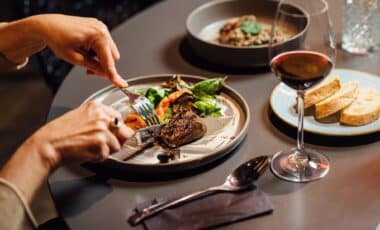
A curry of cassia leaves is beautifully executed with salted mackerel and braised ox tail
House number 100 on Maheseth Road is home to a rustic Thai dining establishment with a casual, cool, down-to-earth vibe that is in keeping with the soulful cuisine the restaurant serves. Although it only opened in late 2017, most nights are bustling with expats and foodies enjoying feasts that some will find eclectic and others adventurous. What is true is that the restaurant’s Isan fare is absolutely sincere in its authenticity and a meal here is a great way to celebrate the traditional Thai New Year this month.
Here, chef-founders Chalee Kader (of modern French bistro Surface and pie place Holy Moly) and Randy Nopprapa (of Japanese restaurant Fillets) stray from their usual culinary brandings to something more akin to their Asian roots. A philosophy meant to advocate sustainable dining, nose-to-tail cuisine centres on utilising every single part of an animal. “We have become so accustomed to the convenience of buying things off the shelf that we barely teach our kids not to waste anything or to appreciate other more eclectic cuts anymore,” says Chalee.
(Relevant: Toro Bangkok Launches Chef Battle: Paella On The Patio)

Chef Chalee provides the finishing touches to a dish
The 37-year-old explains that 100 Mahaseth was originally meant to serve the Vietnamese dish of pho. “We were going to use every part of the cow anyway for the dish, so I thought about how we could make it slightly more interesting,” he says. Drawing inspiration from his frequent travels north and from the cuisine he loves, the Isan nose-to-tail concept became a fitting alternative. “I’ve always wanted to cook something that I eat on a regular basis and that my staff would understand. I wanted a genuine sense of connection to our own culture and nostalgia in the kitchen—and Isan fare was able to do that. We haven’t produced a bowl of pho yet,” he laughs.
Chef Chalee is proud to say that they use almost 100 per cent local ingredients at the restaurant. “We had shareholders who wanted to import beef from Japan or Argentina, for instance, but I was against it,” he says. The restaurant orders its beef from Surin and Nakhon Pathom, salt from Samut Sakhon and black crabs from Khon Kaen, to name a few. “Everything tastes better when it is local and you know exactly where it comes from. Occasionally we get complaints for not serving normal cuts,” he adds. “But we want to stay true to what we believe in and we hope that eventually our efforts will get more people to understand the philosophy behind sustainable eating.”

Roasted bone marrow showcases a superb marriage of flavours and textures

Som tum Luang Prabang is loaded with the freshest ingredients

Fried tripe, one of chef Chalee’s favourite dishes, almost resembles crispy seaweed

A soup of tender beef and offal presents a subtle herbal finish

Chamuang leaf sorbet with juicy grilled pineapple is a refreshing end to a meal
At the restaurant off-cuts and entrails are used to create full flavoured Isan dishes. Chef Chalee brings out one of his favourites—fried tripe. Twice boiled before ageing above the grill and then in the fridge, this four-day process gets rid of the cut’s earthiness and excess water. After deep-frying, the thin pieces of tripe become especially crispy, almost resembling seaweed. Also intriguing is a serving of bone marrow. Coated in charcoal powder before roasting, it is served with toasted perilla seeds tossed in lime, palm sugar, scallions, blood and lemongrass. The crunch and subtle kick from the topping perfectly cuts through the fattiness of the marrow.
A zesty salad of fresh coriander and dill offers a refreshing break before even bolder flavours and textures in dishes such as 100 Mahaseth’s som tum Luang Prabang. It comprises thin slivers of papaya, pla ra—fermented fish made by the mother of one of the staff, fresh kariang chilli, kratin seeds and possibly the best house-fermented black crabs you’ll ever try. “They are harvested during their hibernation period right after the rice cultivation season, so the crabs are especially meaty and fatty,” chef Chalee explains.
(More Tatler reviews: Haoma Plants Seeds Of Change)
His other favourite dish is a beautifully rich cassia leaf curry with ya nang leaves, salted mackerel and braised ox tail. Omitting coconut milk—an ingredient used in central Thai versions—the broth is made from beef stock and grilled buffalo skin. The accompanying hairy eggplant salsa gives a nice acidity and spicy kick, a lovely balance to the full-bodied curry. For a lighter yet equally soulful alternative, recommended is tenderised beef and offal cooked with pla ra and served in a ground-roasted rice broth. Dill and perilla leaves give the soup a herbal punch. To finish a unique meal, try a refreshing bowl of chamuang leaf sorbet and grilled pineapple.
100 Mahaseth
100 Mahaseth Rd
Open 11:30am-10:30pm daily
fb.com/100mahaseth, [email protected], 0-2235-0023







